NBA Elite 11: Q&A With David Littman
We chat with creative director David Littman about the renamed and revitalized basketball franchise from EA Sports.

The last couple of years have seen the basketball video game rivalry become more heated than ever before, as EA Sports and its main rival, 2K Sports, have sought dominance in one of the few sports where exclusive licenses don't come into play. Last year, EA Sports made a splash with its well-received NBA Live 10, a game many critics felt was a turning point for the series and one that signaled a shift in quality for the Live series. Fast-forward to 2010, and things have changed with EA's basketball series, both from a personnel standpoint and, now, with the game's entire approach. As rumored last week--and confirmed today--the NBA Live series has been renamed NBA Elite. Along with the name change will come a new approach to basketball, one that is being led by a name familiar to fans of EA Sports' hockey series: David Littman, who is now spearheading both NHL 11 and NBA Elite 11. We recently caught up with Littman to talk about his new role overseeing both games and to learn more about the new approach for EA's upcoming basketball reboot.
GameSpot: How did you come to be on the NBA Elite 11 project?
David Littman: NHL and NBA have been working together for a while since a lot of features are similar such as Dynasty mode, Season mode, and Online Team Play. But we wanted to take it one step further. NHL has been incredibly successful over the last few years, and the NBA franchise could greatly benefit from the learnings we have had on NHL. I had a vision and design for what I thought the NBA game could be both on and off the court and brought that vision to a few other people at EA. We got a prototype up and running, and it really caught on internally.
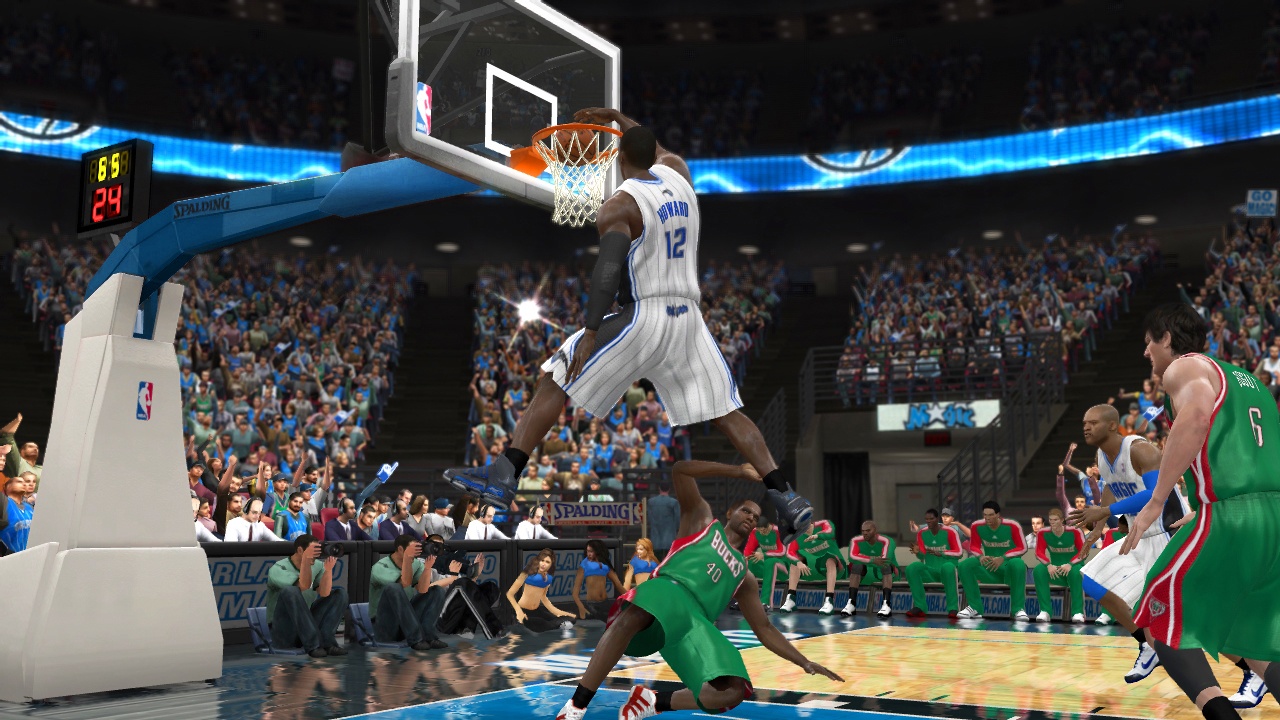
Even more important than that, the studio is putting a lot of people, resources, and new technology behind the game. With the studio success of FIFA, NHL, and Fight Night, it is time for basketball to shine. We have a technology called ANT (Animation Tool Kit) that is miles ahead of any external technology. One of the geniuses behind the technology is a software engineer named Geoff Harrower. Last year, Geoff was named EAC Studio MVP for his groundbreaking contributions to multiple franchises, including FIFA. [You'll be] hearing from Geoff this year as he takes the technology that has been a driving force for a number of other EA Sports award-winning titles and applies it uniquely to the world of basketball video games in NBA Elite 11.
GS: You are highly regarded as a hockey developer, thanks to your work on EA's NHL series. Was there any hesitation in coming to an NBA game?
DL: Not at all. I actually started my career as a tester on Madden when I was living in Orlando. I love all sports games. My pro hockey career certainly helped me move on to the NHL franchise, but I am a gamer first and foremost. I have owned almost every gaming system since my Atari 2600 and have played as many games as I can, including first-person shooters, RPGs, MMOs, and, of course, sports games.
My new role is creative director for both franchises--hockey and basketball--so I still work closely with the NHL team. But it has been a joy and an honor to work with the basketball team. The NBA Elite team has guys from FIFA, NHL, Fight Night, as well as the guys that made NBA Live 10 the highest-rated NBA Live game of this generation. I have brought with me my knowledge of video games, my knowledge of pro sports, and my learning of what made EA Sports' NHL a success. But I am just one piece of the puzzle. There are many other people who you will hear from over the next few months that will make this game a success. This game is not about any individual person. It is about making a realistic basketball game for people who love great Sports games.
GS: Are you a basketball fan? Did being in this position require you to ramp up your knowledge of the sport?
DL: My background is hockey and video games. I do not pretend to be a basketball expert. We have basketball experts on the team. An example of this is Novell Thomas. He is one of our gameplay producers and backed up Steve Nash on the Canadian National team. Everything we put in the game must go through him for the sake of authenticity and realism. Even Novell was skeptical of the new systems. That is until he was able to play it. Novell will be the first guy to tell you (which he will, over the next few months) that this is the most realistic-feeling basketball game he has ever played. Pretty much everyone who has played it has agreed.
Each of our sports games need at least one former professional or college athlete from that sport. We have that on hockey with myself and Dean Richards before me. We have that on NBA with Novell. Most of the team plays basketball here at the studio. Again, I am only one small piece of the puzzle. We have more team leaders other than myself and a dev team that has experience working on some of the best Sports games of all time.
That said, my family had season tickets to the ABA's New York Nets in the early '70s, so I got to see Dr. J play all the time when I was young. My dad played college ball at Brooklyn College, so we had a little basketball in our family besides all of the hockey.
GS: You're leading both the NBA Elite and the NHL teams now. What's the split like for you on a day-to-day basis? Is most of your time spent on NBA Elite these days, or is it relatively even?
DL: There is a line producer on each game. They are the day-to-day leaders of the dev teams. I work closely with them and all producers on both teams, as well as the SEs (software engineers) to help them execute on the vision. I play both games all the time, even on weekends (with some Borderlands and Red Dead Redemption in between). I give my feedback to the producers, and we work together to figure out any changes that need to be made. I do spend more time with the NBA Elite team just because there are so many changes going in every day.
GS: Last year's NBA Live garnered some positive critical response, with the general feeling being that the series was heading in the right direction. In your opinion, what was the series missing? What was your first priority when taking over the project?
DL: NBA Live 10 was a huge improvement. The team did a great job improving the series. When you look at the Metacritic scores, however, neither NBA Live or NBA 2K has been anywhere near FIFA, NHL, MLB The Show, or Fight Night. As a matter of fact, neither game has broken the 85 Metacritic barrier this generation. I believe this is because the basketball category has not had any significant gameplay innovations during this console cycle.
Other sports categories have grown. FIFA and NHL have single-handedly grown the soccer and hockey categories. One of the key drivers of this is their Metacritic ratings. FIFA 10 is 90-plus and NHL has been above 88 for two straight years. People see the quality and innovation that have gone into those series, and they want to buy them, even if it is not their favorite sport. In this economy, gamers are buying less games than they used to. Gamers are reading up about games before they make their purchase. Games have to rise above the noise to stand out. A high-80s Metacritic rating does just that.
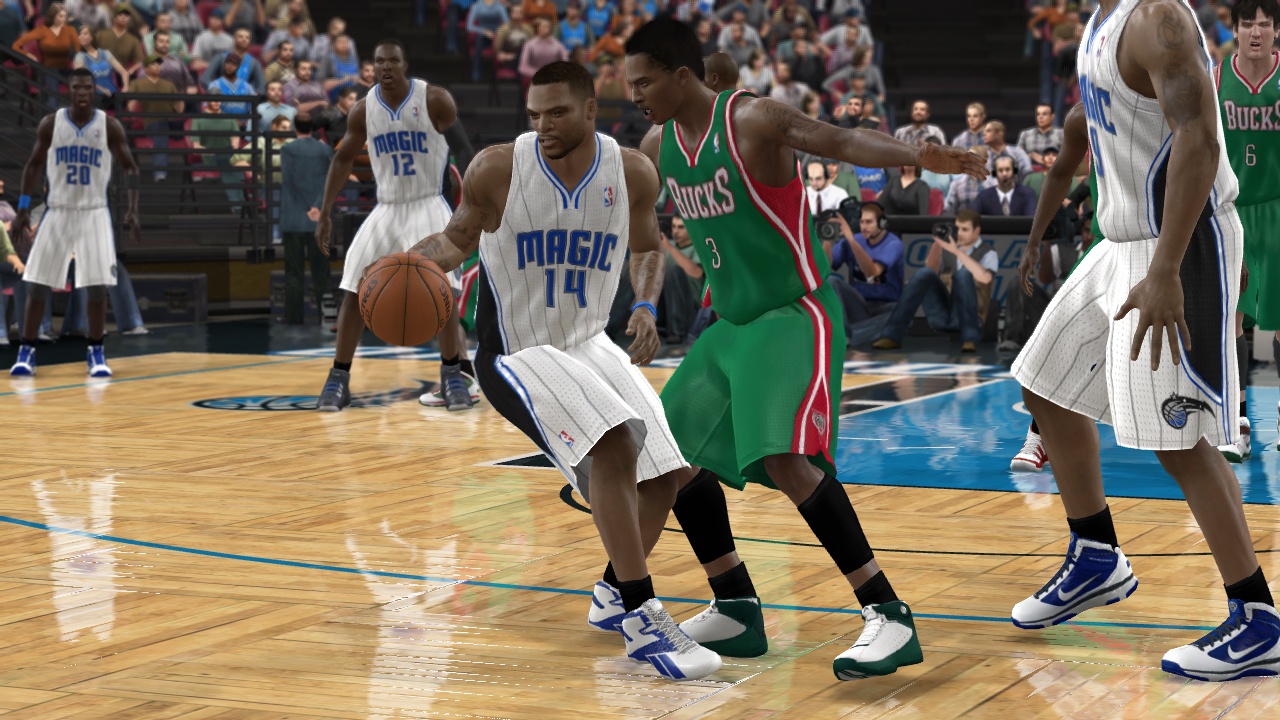
[The new] hands-on controls and real-time physics are the innovations for this generation. They will change the basketball category forever. For the hardcore basketball gamers out there, you will understand when you try out the demo. If you loved the Skate series, the NHL series, Fight Night, or the Tiger series, you can start to understand the key differences NBA Elite will have. These new systems are not gimmicks. They are being implemented because they will help make this the most realistic basketball simulation ever made.
Most importantly is that everything we are doing this year supports these key pillars that have been a big part of NHL and FIFA's success:
- 1. Realism--Make the game as close to the gamer actually being on the court as possible. That means gameplay control and feel, not just the look. It means that shooting, dribbling, and defense are skill-based and not based on under-the-hood dice roles and formulas.
2. Give the gamer the tools to create amazing moments--Basketball games have been all about realistic animations and a broadcast look. Press a button and your NBA player does a 60-frame animation that looks great in replay, but without any of the skill that it takes to pull off. We are simply going to supply the tools that a basketball player has and let the user create moves and great moments just like they would in real life.
3. Easy to pick up and play controls with depth and consistency--Mimic real life as much as possible, and make sure the gamer is 100 percent always in control of his player. We had an NBA Elite 11 one-on-one tourney a couple of months ago with 64 people, including people not on the team who don't play basketball games. All 64 people had a great time, even the ones that lost in the first round. But, most importantly, the winner was gameplay producer Conner Dougan because he had the most hands-on time with the game and has by far the most skills so far. One magazine writer who played it said that for the first time he had complete control over his layups/dunks, which hand he finished with, and knew when he put up a bad shot.
4. Anything can happen/emergent gameplay--Real-time physics and hands-on controls are two new innovations, but that is not even close to what else is new. We have over 200 gameplay improvements, including a ball that is almost always considered "loose." We had a play yesterday where I went to block a shot, and Novell made a pass instead of shooting. The pass hit my player in the arm and went to my teammate who was off on a fast break. Every time up the court you can see something new and different.
5. Make the gamer the star of the game--Gameplay is only a piece of the puzzle. There are modes both online and offline where I thought the NBA game was lacking. That is not an issue anymore. (More to come on these modes at a later date.)
GS: Let's talk about some of the specific features in the game. The team is implementing dual-stick controls, which worked extremely well in the NHL series. How are you adapting them to work with hoops?
DL: It is incredibly fun to go out on the ice in real life and shoot a puck around. So on NHL, we simply did our best to replicate that feeling. The left stick is your skates. The right stick is your hockey stick. You have complete freedom to deke (RS side-to-side and rollbacks), shoot (RS up), and check (aim RS at opposing player) just with the sticks. That fun factor is exactly what we wanted to capture. It is a lot of fun to go on the court and shoot a basketball.
So, we are simply doing our best to replicate that feeling. The left stick is your feet. The right stick is your hands. You will have complete freedom to dribble (RS side-to-side, RS rolls for spins, behind-the-backs), shoot (RS up), and play defense (RS down to steal, RS up to jump, RS to the sides for arms up and to block passes). Dribble moves really matter. Doing a hesi with an explosive first step can beat a defender. Doing a behind-the-back or between-the-legs dribble can protect the ball against a steal attempt. Spin moves can leave a defender in the dust.
The best part is that the new controls also make defense really powerful. I have found that playing defense in basketball games can be really frustrating. With the new controls and physics, playing defense is not only fun, but very powerful. Steals, blocks, and pass interceptions are done with the right stick. You can track an opponent from behind and do a LeBron-like block off the backboard. We will have the analog sticks visualized on the screen so you can see exactly what you are doing with the sticks. This will be set to on during the interactive tutorial, manual replay, and in one-on-one practice mode.
It is important to note that this is not a remapping of the controls. This is a new system with one-to-one control of the ball. The ANT technology that we use gives us the ability to separate the upper and lower body, to blend all animations, and to use real-time physics for player contact at the same time. And, yes, you will be able to use button controls like last year, but you won't want to when you see the freedom that the new controls give you.
GS: There's a new shooting mechanic too, one that sounds a bit like the skill stick in the NHL series. How will it work?
DL: In real life, shooting is skill based. Players practice every day to become better shooters. In basketball video games, shooting has not had much skill attached. Sure there is some skill to get it to your best shooter who is open for a shot, but that is more strategy than skill. Once a player shoots in almost every basketball game ever made, it is up to player attributes, how open he is, an under-the-hood formula, and a tiny bit of when you release the button to determine if the shot will go in. I do not feel very satisfied when I make a shot in basketball games. With the new shooting mechanic, it is all skill based, but at the same time it users player attributes. If you have played Tiger Woods golf, you have an idea of what the shooting mechanic is.
The shot is based on real life. You move the right stick up to start your shot and release it to release the ball. You have control of the accuracy and the distance. If you move the RS perfectly up to 12:00, your shot will go straight. If you miss left, the ball will go left. Miss it right, and the ball will go right. When you release the ball will control the distance. Release early, and the shot will be short. Release late, and the shot will be long. The system is so realistic that you can do manual bank shots by purposely aiming left or right and a bit long.
When you have the left stick towards the basket and you are close enough, moving the RS up will dunk the ball. Roll the RS up from the left, and you will do a left-handed layup. Roll it up from the right, and you will do a right-handed layup. Roll the RS up from a back down, and you will do a hook shot. The RS becomes an extension of your real-life hands, and it is not only realistic but incredibly satisfying when you hit a three to win the game. Even when you miss, you know it was your own fault. The sense of pressure near the end of a game becomes real, and you may miss a shot because of nerves.
So how do player attributes come into play? It's simple. Your tools become harder to work with. Here is an example of the sweet spot:
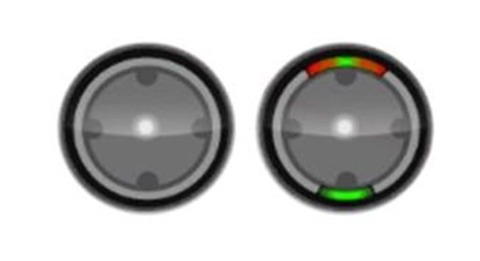
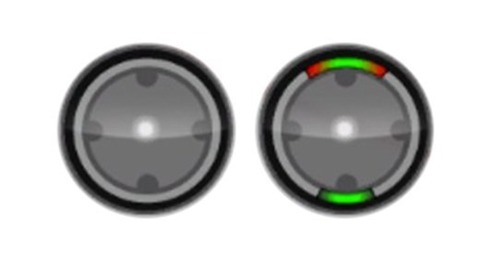
If people are concerned that because it is skill-based shooting you can make every shot, then you can relax. Shots are harder to make if you are further away from the basket, are being closely guarded, are a below-average shooter, or you have too much fade or momentum, among other factors.
GS: Give us some specific examples of how the new controls will work for moves like fadeaways, dunks, layups, and so on, as well as defensive moves such as blocks and steals.
DL: So I mentioned how most of the basic controls work. But the best part of the new control system working closely with the physics system is the depth of creativity that you have this year. Here are some examples:
• For fadeaways and leaners it is simply a matter of where your left stick is when you shoot. You are in control. If you want to do a fadeaway, just move the left stick away from the basket and shoot.
• For the first time the user will be able to perform manual bank shots. Aim the RS to the near side of the backboard, and shoot it with a bit more power.
• For gathers, euro-steps, and pro-hops, you hold or tap the left trigger. For the first time, you have full control of your movement during a pro-hop and during a euro-step with the left analog.
• While dunking, you can even manually switch hands while in the air by moving the RS left or right.
• One more important thing that our ANT technology gives us is upper- and lower-body separation. For the first time, you can do things with your arms in one direction while moving in the opposite direction. So, for example, in basketball games of the past, when you hit the steal button, you play a canned full-body animation. But just like in real life, in Elite you can be moving backwards and still take a swipe at the ball with the RS, and it doesn't change your movement at all.
GS: NBA Elite will also feature a new physics system. What does it do for players that the old system could not?
DL: The new real-time physics system is a revolution. In NBA Live 06 through 10, we used two-player scenarios that took control away from the gamer in order for plays to happen that "looked" realistic. The problem was that it didn't "feel" realistic.
I [recently] watched a video on YouTube by a guy (I think his name is apexisfree) showing the scenario-based one-on-ones in our competition's game, where you actually lose control of your user-controlled defender in order for the offensive player to get around you. None of these things happen in NBA Elite 11, because it is using a real-time physics system. You will see in-air collisions, realistic back-down physics, upper- and lower-body separation as mentioned earlier--all the while you are in control of your player. Player attributes actually mean a lot more than in previous years. We are using the weight and strength of the players to drive the physics engine. If I am trying to back you down, but I am much smaller than you are, you won't move very far. But big players will be able to dominate in the paint. When I go up for a rebound, bigger stronger players have the advantage.
GS: It sounds like the elimination of extended canned animations--which have been a staple in basketball games for years--will put a huge burden on NBA Elite's individual player AI, especially in terms of things like set plays, pick and rolls, and so on. What has that side of development been like so far? What are the team's goals for this year in that regard? Are you looking to get it working and refine for NBA Elite 12? Or are you further along than folks might think?
DL: One thing I want people to understand is that we are building off of the great work that was in NBA Live 10. Most everything people liked about the game is still there. We are not starting from scratch. You will still be able to do set plays, screens, and pick and rolls (all with real physics and not canned scenarios). We are improving on what people liked. I haven't even touched on the new REAL-AI system (originally in NHL and Fight Night), where producers can play the game, and the AI will be able to use the best, most successful moves/shots that we have done right back against us. It is like playing against a human. You will hear and see much more about it over the coming months.
As I said earlier, EA Sports is going big with basketball this year. We have an incredibly talented team with a technology that allows for extremely fast iteration and change (what used to take a few days can now be changed in minutes). People are going to be very surprised at what a motivated team can accomplish in one year. We have hundreds of new gameplay improvements and enhancements. Even for gamers who choose to use the button controls instead of the new hands-on controls, the game is so improved they will still want to experience all it has to offer.
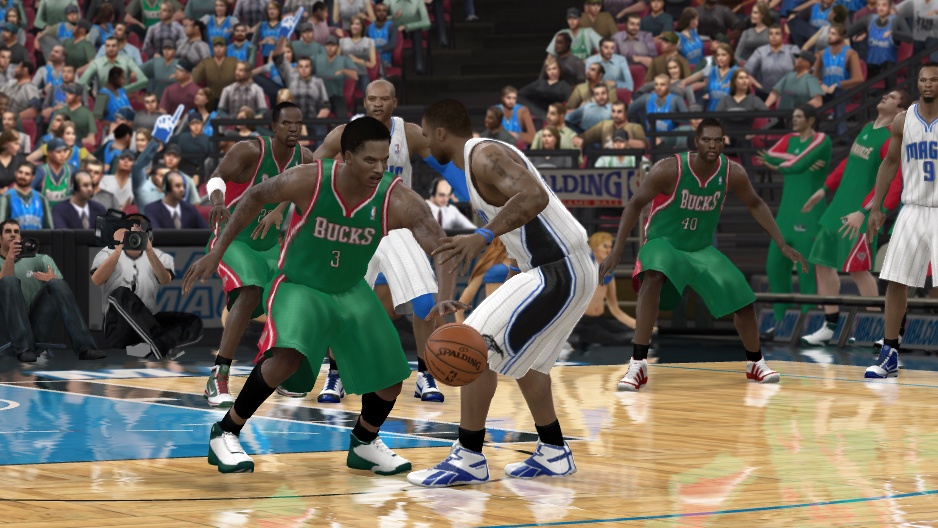
GS: In recent years we've seen a lot of public back-and-forth between EA Sports and 2K Sports when it comes to basketball games--some of it healthy rivalry, some of it a bit childish. What's your take on all of this, and how do you view the competition?
DL: I think that both basketball games were concentrating so much on beating each other that they forgot about the gamers. We are in this business to make great games, not to get involved in public bickering. It might be one of the reasons that basketball games have been left behind in this generation. Metacritic numbers are lower than other sports. The gamers and the reviewers have spoken with their words and their wallets. That ends this year with NBA Elite 11. The first thing I said when I came onto NBA was that we are fighting the wrong battle. We need to be comparing ourselves to FIFA, NHL, and MLB The Show.
Having said that, competition is healthy, and basketball has a great rivalry going right now. I look forward to competing with a very worthy competitor. It is going to be a fun year, and the fans of basketball games will benefit the most from this competition.
GS: Why the name change?
DL: We thought it was important that people understand that this is not just talk. We are changing basketball games forever. They will never be the same after people try NBA Elite. We have a direction we are very confident with. Our NBA franchise, and the category itself, needed a change, not just some incremental improvements. Just like [EA Sports' previous baseball series] Triple Play needed before it became MVP Baseball with a new mechanic and feature set. Just like [EA Sports' previous boxing series] Knockout Kings needed until it became Fight Night with a new mechanic and feature set. This is not just talk. We are serious about change, and we will do everything we can to alert people to that fact.
GS: Final question: Who's going to win the NBA Championship this year and why?
DL: I don't like to guess about the outcome of Sports games, as I like to enjoy watching them without worrying about who will win. But, I did go to Boston College, so…
GS: Thanks for your time, David.
Got a news tip or want to contact us directly? Email news@gamespot.com
Join the conversation